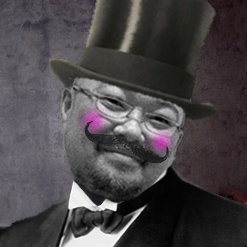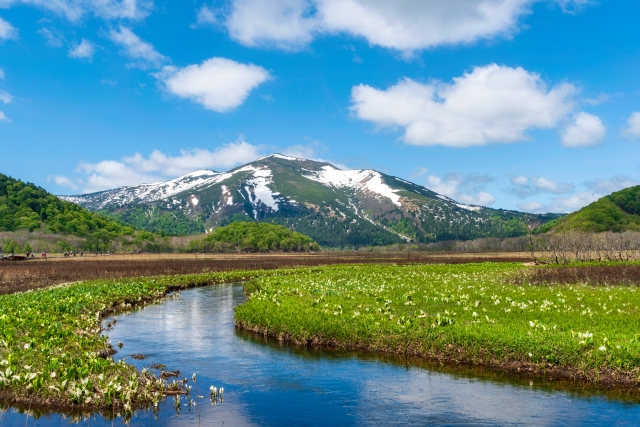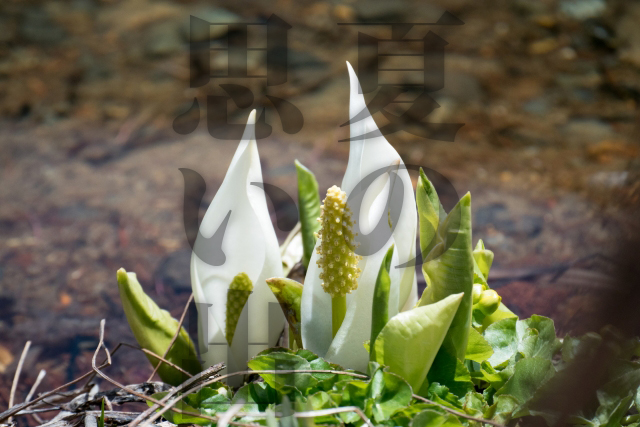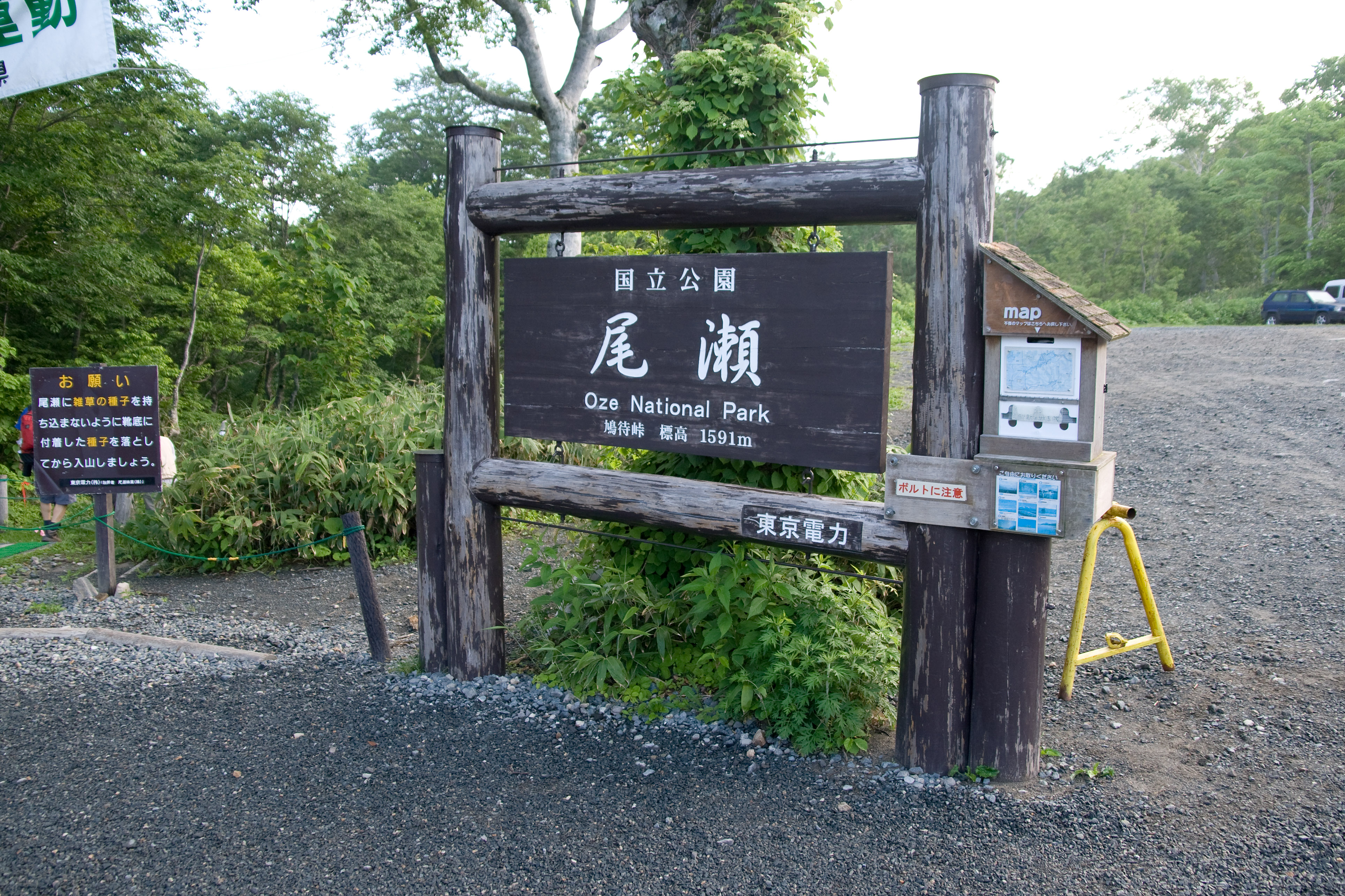Natsu no omoide
Natsu ga kureba omoidasu
Harukana oze tooi soraKiri no nakani ukabikuru
Yasasii kage nono komichiMizubasyou no hana ga saiteiru
Yumemite saiteiru mizu no hotoriShakunage ironi tasogareru
Harukana oze tooi soraNatsu ga kureba omoidasu
Harukana oze tooi soraHanano nakani soyosoyo to
Yure yureru ukishima yoMizubasyou no hana ga niotteiru
Yumemite niotteiru mizu no hotoriManako tsubureba natsukashii
Harukana oze tooi soraLyricist:EMA Shouko
Composer:NAKATA Yoshinao
in 1949
Summer Memories
I remember every time summer runs
far way oze, A very clear sky
I can see vaguely in the fog
Gently shadow, Path in the field
The flower of Asian skunk cabbage is blooming
Dreaming and blooming in around the water
Twigs in the color of rhododendron
far way oze, A very clear sky
I remember every time summer runs
far way oze, A very clear sky
Gently shake in the flower,Gently … gently follow
On a floating island while fluttering
The flower of Asian skunk cabbage is smelling
Dreaming and smelling in around the water
I will remember if I close my eyes
far way oze, A very clear sky

Summer Memories — The Birth of a Musical Treasure in Post-War Japan
Picture Japan in 1949, just four years after World War II had ended. The country was rebuilding, and people were searching for ways to bring families together again. It was during this time that NHK, Japan’s national broadcasting corporation, launched an innovative program called “Radio Kayou” (Radio Songs). This wasn’t just another music program – it was born from a deep desire to heal and unite. Perhaps reflecting on how wartime propaganda songs like “Kokumin Kayou” had once stirred nationalistic fervor, NHK now wanted to create something entirely different: gentle melodies that families could gather around their radios to sing together in the comfort of their homes.
From this thoughtful initiative emerged “Natsu no Omoide” (Summer Memories), a song that would capture the hearts of generations of Japanese people. Today, this beautiful piece remains one of the most cherished examples of Douyo-Shouka – traditional Japanese songs that blend folk melodies with poetic lyrics. What makes this song so enduringly popular isn’t just its haunting melody, but its ability to paint vivid pictures of Japan’s pristine natural beauty through music and words.

A Lyrical Journey Through Japan’s Hidden Paradise
The song takes us on a poetic journey to Oze, a breathtaking highland marshland that feels like stepping into a fairy tale. This remarkable wetland ecosystem stretches majestically across three prefectures – Fukushima, Niigata, and Gunma – and holds the prestigious designation of being both a national park and one of Japan’s 100 most scenic spots. When you imagine Japan’s natural wonders, you might think of Mount Fuji or cherry blossoms, but Oze represents something equally magical yet more intimate.
The area is renowned for its incredibly strict environmental conservation policies, which have kept this wilderness virtually untouched for decades. Visitors must follow wooden boardwalks that wind through the marshland, ensuring that every footstep respects the delicate ecosystem. This careful preservation means that when you visit Oze today, you’re experiencing the same pristine beauty that inspired the song’s creation over 70 years ago. The commitment to protecting this natural sanctuary reflects the Japanese philosophy of living in harmony with nature – a theme that resonates deeply throughout the song.
The Story Behind the Words: A Wartime Memory Transformed
The woman who penned these evocative lyrics, EMA Shouko, has a fascinating story that adds layers of meaning to the song. In 1944, as World War II was reaching its devastating climax, she was evacuated to the Oze region for safety. Instead of dwelling on the hardships of wartime displacement, EMA found herself captivated by the area’s otherworldly beauty. Her lyrics were born not from a casual tourist visit, but from the deep, contemplative experience of someone who had time to truly observe and absorb the subtle rhythms of this highland paradise.
This personal connection explains why the song feels so authentic and emotionally resonant. EMA wasn’t just describing a pretty landscape – she was sharing a profound experience that had sustained her spirit during one of the darkest periods in modern Japanese history. The song became her love letter to a place that had offered solace and wonder when the world seemed broken. This backstory transforms “Natsu no Omoide” from a simple nature song into something much more profound: a testament to the healing power of natural beauty and the human capacity to find hope in the midst of despair.
The Beautiful Mystery of Seasonal Poetry
Here’s where the song becomes wonderfully intriguing: the star of “Natsu no Omoide” is the Mizubasho (Asian skunk cabbage), a plant whose large white petals create stunning displays across Oze’s wetlands. However, these magnificent flowers actually bloom from late May through June, right after the snow melts – not during the height of summer that the song’s title suggests. When curious fans pointed out this apparent contradiction to EMA Shouko, her response was both poetic and revealing: “I call the wonderful season of Mizubasho in Oze ‘summer’.”
This beautiful explanation opens up a window into the Japanese appreciation for seasonal subtlety. In traditional Japanese culture, seasons aren’t rigid calendar categories but fluid, emotional experiences. According to the classical seasonal calendar used in poetry and literature, Mizubasho is indeed considered a summer season word, reflecting an ancient understanding that nature’s rhythms don’t always match our modern calendar divisions. Even beyond the famous Mizubasho season, Oze continues to enchant visitors throughout the year with its ever-changing tapestry of colors: the fluffy white Watasuge (cotton grass) dancing in summer breezes, the bright yellow Nikkoukisuge lilies, and the spectacular Kusamomiji – the autumn transformation when grasses turn brilliant shades of red and gold, creating their own version of fall foliage.
▼How to go Ozegahara







コメント